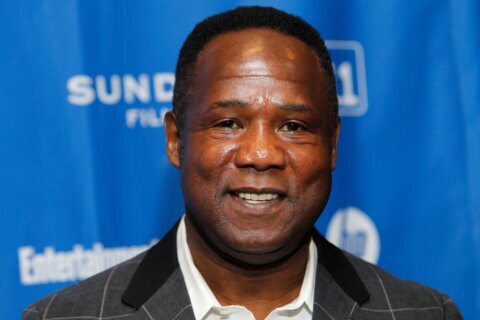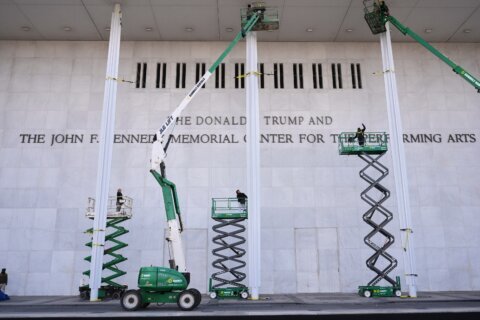Hear our full conversation on my podcast “Beyond the Fame.”
Her grandfather, Ub Iwerks, met Walt Disney at an art studio in Kansas City in 1919, before becoming his chief animator on Laugh-O-Gram cartoons in 1922. After moving to Los Angeles in 1923, they made history together by co-creating Mickey Mouse in 1928.
“They did Oswald the Lucky Rabbit … but that character got taken away from them through a deal that Walt did,” Leslie Iwerks told WTOP. “Walt needed a new character and my grandfather came up with Mickey Mouse. … The first [film] was ‘Plane Crazy,’ then ‘Steamboat Willie’ was the rocket ship that took off as the first synced-sound cartoon.”
Now, she has written the book “The Imagineering Story,” chronicling the history of Walt Disney Imagineering to create memorable experiences at theme parks and beyond. The book is a companion piece to the recent six-hour documentary series on Disney+.
“It was really successful, very embraced by fans around the world who loved and wanted to experience the history of the parks,” Iwerks said. “I interviewed over 200 people and have interviewed even more since. We had so much material that was left on the cutting room floor. … So many of the stories that couldn’t make the film made it into the book.”
Walt Disney coined the catchy phrase “Imagineering” as a combination of “imagination and engineering” to provide an umbrella term for creating uniquely experiential theme parks.
“There are so many different disciplines within imagineering, they have over 500 patents for technologies,” Iwerks said. “You translate that to 12 theme parks around the world from the tiniest detail to the broadcast land. … When you step into a park or restaurant or hotel, it’s the theming, design work, live entertainment, everything falls under imagineering.”
Founded in 1952, Walt Disney Imagineering was initially created to open Disneyland in Anaheim, California, in 1955. While the venture was obviously massively successful in hindsight, it was a risky endeavor at the time when many theme parks were dying off.
“Theme parks were considered dirty and déclassé … but Walt traveled the world and one of his inspirations was Tivoli Gardens in Copenhagen,” Iwerks said. “The fact that this was just a concept in Anaheim in orange groves that no one really believe in and ended up taking off like wildfire is a true success story — and this book chronicles that evolution.”
Designed with Sleeping Beauty’s castle at the center and Main Street U.S.A. at the entrance, Disneyland visitors travel between distinct lands, including Tomorrowland, Frontierland, Adventureland, Fantasyland and Mickey’s Toontown where the mice “live.”
“Walt came out of the Midwest so he wanted that Main Street feel of boutique stores … then the idea of a cross-dissolve in the ground,” Iwerks said. “When you’d go from one land to the other, you didn’t think about it, but the texture of the ground would change. Cobblestones lead to a smoother, modern feel. … It was always the subtle things.”
After Walt Disney ‘sdeath in 1966, his brother Roy Disney oversaw expansion of “The Florida Project” as Disney World opened in Orlando, Florida in 1971. The centerpiece would be Cinderella’s castle at the Magic Kingdom, followed by the addition of three satellite parks: Epcot in 1982, Disney Hollywood Studios in 1989 and Animal Kingdom in 1998.
“Roy took the baton from Walt and really wanted to complete Walt’s dream,” Iwerks said. “A lot of people were nervous about being able to pull off Disney World, but Roy was the one who made it happen. Roy championed it, but unfortunately it took a toll on him. He died shortly after the opening but seeded the DNA so more Imagineers could continue on.”
Indeed, multiple generations have enjoyed Disney’s iconic feats of theme-park ingenuity, most famously the animatronics on attractions like “It’s a Small World,” “Pirates of the Caribbean,” “Splash Mountain,” “Space Mountain” and “The Haunted Mansion.”
“From the tiki bird way back in the early days through the Hall of Presidents’ Lincoln figure to the A1000 animatronic figure in Star Wars: Galaxy’s Edge where they are almost digital now,” Iwerks said. “It ranges everything from the ride system to the animatronic figures to the projection technology to the robotics within the ride to propel you up and down.”
As new technologies continue to push the Disney theme parks into the future, the company continues to fulfill Walt Disney’s grand vision of taking images in his brain and making them real.
“He really felt like there was a limit to film. You can only watch things in 2D, so he felt that if you could experience it and take his I.P. and bring it to life and let you feel it, live it, breathe it and meet it, meet these characters standing there live, it’s a whole different blow-your-mind new kind of virtual reality world, only it’s not virtual reality, it’s reality.”
Hear our full conversation on my podcast “Beyond the Fame.”








